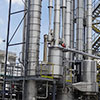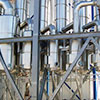Rising Film Evaporator
Rising film evaporators are of the shell and tube type, in which the product circulates inside the tubes and the steam through the shell side, heating the exterior tube walls. They were the first kind of shell and tub evaporators designed. They are currently used in very few applications, due to technological advances that allowed to find more efficient and adequate configurations, like falling film evaporators.
The working principle of rising film evaporators is by themo-siphon, in which the heat liquid climbs up the tube walls driven by the vertical force generated by density changes in the liquid and the generated vapors when contacting the hot walls of the tubes.
Unlike falling film evaporators, the liquid in these equipments enters the evaporator through the bottom part and climbs evenly through the tubes until it reaches a vapor separator placed at the top where vapor and concentrated product are separated.
The concentrated liquid can then be sent to the next effect or part of it may be recirculated in the same effect. In rising film evaporators there has to be a large temperature difference between vapor and liquid to favor an intense evaporation and increase turbulence and vertical speed or the heat transfer coefficients would be too low. Besides, tube length is usually shorter than in falling film evaporators, topping at 6 or 7 meters.
These equipments have the advantage of not needing pumps to transfer the product to the next effect, but on the other hand slower circulation speeds and lower turbulence are achieved which prevents high heat transfer coefficients and favors fouling.
Main Features
- No product transfer pumps required
- Large temperature differences between vapor and product required
- Shorter tuve length



